#the vast majority of borderlines are far more likely to harm / off themselves than they are you lol i promise
Text

this is one of the first things that comes up when you look into what it might be like to have a borderline partner. tell me again about how bpd is not among the most stigmatized mental conditions ?
#bpd#one of these days i really need to sit down and make a giant post about#the phenomenon of bpd resources being ( almost ) wholly catered to living With borderlines#rather than advice for the actual borderline themself#and how with bpd specifically that is one of the most detrimental things you could ever do#now is not that day but until then just fucking be nice. it is not difficult#the vast majority of borderlines are far more likely to harm / off themselves than they are you lol i promise#i have prattled about this shit before but god i am so sick of it#if y'all were demonizing literally any other mental illness this way you would be rightly ridiculed for being absurdly ableist#yet because bpd is a Scary mental illness that is centered around abuse ( whether the borderline is abused / abuser / both )#it's somehow okay to just throw every borderline to the dogs and hope that they kill themselves ? because they're all rancid abusers ig ?#apologies i have strong feelings about this shit lol#i am sure that nothing is worded super well ( again i need to sit down and make a real post about it sometime )#🦷
6 notes
·
View notes
Note
I'm not Jewish myself but I do belong to a couple of minority demographics that receive denigration for one reason or another, along with people trying to speak for me.
My only real advice is that there comes a point where it's no longer "defending the oppressed" and more infantilization. There is such a thing as being too sensitive. This is a kid's game, not propaganda meant to encourage hatred. Same as any other demographic, Jewish people can speak on their own behalf. They don't need others' help, they only need a listening ear. To do anything else is risking spoiling the fun for everyone including those you're trying to speak for.
Also "goblin" as far as I've seen is as much an umbrella term as anything else. Jewish people don't hold a cultural copyright on financial greed and hooked noses. (may I direct you to dragons and stereotypical witches respectively) I could probably name a dozen other fairy tale and mythological creatures that have such traits.
Suggesting that SSO's new little green goblin (Grinch? Norman Osborn?) is a caricature of Jewish people makes as much sense as saying the orcs in Tolkien's legendarium represent black people or that the white walkers from ASOIAF represent white people, aka little to no sense once you look past the surface. The comparison of Jewish people and goblins alone could be deemed borderline antisemitic in itself. It's misguided, but forgivable.
Worry more about enjoying the game and less about whether SSO is offending a group who are more than capable of defending themselves in a kid's game. ❤️
Okay I don’t blame you for assuming I’m not Jewish because apparently I haven’t mentioned that here yet even though I (mis)remembered I had, but this still feels really weird to send?
Telling someone who’s not part of a minority to not speak for them is absolutely okay, the job of people outside a minority is to raise up their voices, not add their own, so I have no issue with that aspect and I am genuinely sorry that’s been done to you, but why are you, someone who by your own words isn’t Jewish, speaking on if goblins antisemitic or not at all? You are speaking for/over us there, and you would be even if I wasn’t Jewish.
I am Jewish, and obviously while we aren’t a monolith, no group of people is, I personally find this depiction of goblins (green and greedy/thief) antisemitic, and with much of the world going mask off with their antisemitism right now I’m not as open to giving benefits of the doubt as I used to be. I do believe this was a mistake on SSO’s part and not intentional as I said in a reblog, but that doesn’t make it any less harmful or antisemitic.
I have done quite a bit of research into the history of goblins and when they began to be used as an antisemitic caricature (as early as the 1800s thanks to the Goblin Market poem, which is just classic blood libel) because I make dice as a job and I want to enjoy D&D without antisemitism and the whole dice goblin thing, and there is a very large connection. This isn't unfounded.
You’re right in that goblins are a bit of an umbrella term, they are, which is why it’s important to let the antisemitic version of them die. You can have goblins that are just mischievous, not green, big nosed, greedy, sneaky, and untrustworthy. It’s really easy to not have antisemitic goblins, but unfortunately the antisemitic version is a mainstream staple and that doesn’t just go away overnight.
If you apply harmful stereotypes to anything, even if it was completely harmless before, you’re going to get a harmful caricature. That’s what happened to goblins, and that’s what SSO did with the Snow Goblins.
They took the popular depiction which is the antisemitic version, and applied it to the game without a thought because it’s been normalized to the point most people don’t even consider it may have less than great origins. Like Rapunzel and Hansel and Gretel. They’re so normal the vast majority of people don’t even realize they were created for antisemitic reasons. Antisemitism is sneakily within a lot of things. You don’t start recognizing it until you become familiar with the tropes and stereotypes.
I’m also going to bet if they’re European in origin, the “dozen other fairy tale and mythological creatures that have such traits” you could name also had that done to them if they weren’t antisemitic to begin with. And since you mentioned them, it’s also what was done to the stereotypical version of witches, which is antisemitic and has a very long history of such going back to accused women who were burned being forced to wear Jewish clothing of the time as further humiliation. It’s also where the classic pointy hat comes from, since a pointy cone hat was what we were forced to wear to signify we were Jewish. Witches actually share a lot with goblins in antisemitic traits and SSO also needs to address Pi hitting all but the green skin.
You clearly know a little about the issue, as you brought up The Nose when I didn't, but you also don't know nearly enough to speak about this at all as evidenced by you not knowing the antisemitic history regarding witches, so please don't. And I never said they were a Jewish caricature, I said they were antisemitic, there's a difference. A Jewish caricature is the happy merchant meme.
What we're also not going to do is the whole 'you're the antisemitic one for seeing Jewish people in goblins' thing. That has and always will be an utterly bullshit dismissive argument. The whole point of this kind of caricature is to normalize the stereotypes so when they're actually applied to people you don't blink an eye, like how very few goyim blinked an eye at Mother Gothel in Tangled. I'm currently sick so I really don't have all the smart brain power to go into that right now and I hope someone else can. It's not antisemitic to notice when antisemitic caricatures have been applied to something. That's a very good thing to notice actually, and I want more goyim to start noticing that.
So it does actually make more sense than someone saying those things (which I don't think I've ever seen someone argue??), which I'll get into under the cut to clear up any confusion about how SSO's Snow Goblins tie into the antisemitic depictions, since a couple people were confused in my initial post.
And I am worrying more about enjoying the game; that's the whole reason I brought this up, because I'd like to enjoy a game that's been with me for more than half my life and means a lot to me, and this is preventing me from fully doing that.
Again, I am genuinely sorry people have spoken over and for you. That is wrong and not at all okay. And I'm sorry if I misread the tone of your ask.
Okay !! Education with Mandy time. This has been a long post but I hope you'll all stick with me for just a little longer.
And real quick before we get into the specifics, I want to mention that Christmas time is one of the times where you want to be especially careful about things like this, given the history present with characters like Scrooge.
So for those who don't know what the Snow Goblin is, this is the creature in question:

The typical antisemitic goblin is green, greedy, big nosed, and some flavor or sneaky and untrustworthy.
The Snow Goblin quite obviously hits on the green. If this creature looked like a normal capran and was named something like Snow Imp or Mischievous Capran, there would be no issue. Because bastardy little guys stealing things on it's own isn't an antisemitic stereotype. It's when there's multiple things that are the problem, like green skin, or in this case fur, and calling them something with a very large history of antisemitism when combined with those very traits.
The whole schtick of this little guy is they steal your snowflakes if you don't catch them in time, so it also hits on the greedy and untrustworthy tropes. If the Snow Goblin looked like a normal capran but was still called a goblin, there would still be an issue because the antisemitic goblin isn't just green, it's also bastard of greedy kinds, like a thief not out of necessity but of pleasure. "Thief" isn't directly an antisemitic stereotype, but it's very much there as an undercurrent. The "Jewish people are unfairly taking my money!" implication from The Middle Ages when the stereotype began, when money lender was pretty much the only job we were allowed to have.
If the Snow Goblin was called something else but was still green, I wouldn't say its directly antisemitic, but I would side eye it and not feel comfortable. It's kinda like the Grinch, ignoring the fact Dr. Seuss may or may not have been Jewish depending on who you ask because there's conflicting information. It's not directly anything bad, but I'm going to be a little wary of the intention and engage with it extra carefully.
Its about the combination.
I can't tell you exactly when the mainstream antisemitic goblin came together, because I don't know and it's really hard to find information on that, but it's there, and you can't deny that. I don't necessarily blame SSO for contributing to it's perpetuation, because you don't think to look deeper into something when you have no reason to think it's harmful, but I do hope they change it. And hire some Jewish sensitivity readers because this wouldn't have happened with more Jewish people around to catch it, and with witches being a focus of the story now I am admittedly a little nervous about how that'll be handled.
Also, this is all unintentionally made worse by use of the capran model, because it also gets to hit on the whole fun we're in league with the devil thing and the Jewish people have horns thing. I don't know when exactly those started either (drawings of us with "devil features" have been around a long time), but I know the we have horns one was popularized when Michelangelo decided to give his sculpture of Moses horns, because that's what we look like apparently. There are still people who genuinely believe we have horns. I feel robbed. Horns a super cool, I want horns. Where are my horns?
And before someone says it, yes this is a lot of words for something low stakes in a kids game. There are a lot of more important things right now. But that's exactly why it's mattering to me right now. I don't want to be silent about antisemitism while it's on the rise, but I don't know enough about the current aspects of that to speak on it. I do however know a lot about how it applies to fantasy, and I have had about three work in progress essays about the goblin issue to prepare for this.
And also before someone says it, Snow Gremlin isn't exactly an acceptable new name either. It's basically Snow Goblin 2.0. Gremlins aren't goblins (though they have become a bit synonymous and interchangeable), but they were popularized by the massive and proud antisemite Roald Dahl, and I have a hard time believing he didn't put any of those beliefs into them.
#star stable#star stable online#sso#sso critical#long post#antisemitism#jumblr#<- hoping some jumblr peeps can help explain why this ask feels so :/ to me#also side note but who's fun am i spoiling#the snow goblin's mechanic is horribly unfun even without this#it's just punishing#no essence of enjoyment in sight because there's a time limit that's really freaking short#and i know i essentially repeat myself a lot i am nothing if not a redundant girlie <3 lady redundant woman in world girl gets me
47 notes
·
View notes
Text
Hungry Things
for my own reference and for the reference of others, below are all my huge and hungry critters that prowl between the infinite realms.
This isn’t a complete list, and will likely have more things added onto it later/as I remember things, but for now enjoy.
The Gardener
The biggest and hungriest, and has the honor of being a part of the greater machinations of the infinite realms. The Gardener is responsible for getting rid of all planes that are dead or dying, as their existence poses some kind of threat to “healthier” realities. While normally its duties mean it does not directly antagonize sapient life, the machinations of powerful beings will sometimes cause it to bite down on planes that do not deserve it yet.
The Maggots/The Sea of Teeth
The parasites that cling to the Gardener are without number, forming a literal sea of bodies that writhe continuously across its surface. Incapable of actually harming it, they mostly squabble and fight among themselves for cosmic detritus and scraps that drift by as a result of the Gardener’s latest meal. While some are actually intelligent and some could truly be called gods in their own right, the vast majority of them barely borderline our definition of “sentient” and are simply guided by their own hunger.
The Maggots slither en masse into the cracked shell of whatever realm the Gardener is feeding on, aiming to sate whatever appetites they possess in whatever way they can, and do not care what gets in their way. Even other maggots fall victim to their greaters, as they cannot be truly called a “kind,” “kin,” or “allies;” their only drive is to consume, and woe fall onto anything that would interrupt them.
The Maggots, by and large, are harmless to most realities so long as they’re not summoned into one by some fool seeking power. Some may scheme, some may step out of bounds, some may break away to grab a snack on their own, but the reason many of them become maggots in the first place is because the Gardener always assures a relatively easy meal. There will always be food in its wake, and even the gods among the Sea of Teeth hesitate to risk the good thing they have going just for some fresher food.
Monenalpa
Also known as the Glutton, the Planar Parasite, or a wide variety of other unpleasant names, Monenalpa is a living, sentient (though far from sapient) plane of existence. It consists of nothing more than an eternity of winding, tooth-lined throats, spine-filled intestines, pits of gastric acid the size of planets, writhing, grasping limbs and other morbid features broken up only by its smaller, internal manifestations... And the struggling civilizations that have formed inside, the remnants of its past meals that have refused digestion.
Monenalpa clings to other realities and sinks itself inside, slithering its various limbs through its layers as it finds weak points to manifest through. All of its manifestations are hungering monsters, beasts whose anatomies are little more than mouths and a means to transfer matter into them, all of the throats leading directly to the gluttonous realm itself. As the parisitized plane weakens, either through the passage of time or the corrupting effects of Monenalpa, more and more of its manifestations will emerge as the parasite slowly squeezes its way inside to feast more directly.
Its mere presence causes planar laws to go haywire. Forces which bend space and time create weaknesses that Monenalpa can exploit, teleportation or portal systems have greater and greater chances of opening up into the being’s winding guts, and extradimensional spaces randomly become another orifice through which it can feed. Monenalpa is incredibly hard to dislodge once it has latched on; usually, the only thing inhabitants of a parasitized plane can do is drive off the creature’s feeding limbs until it decides that the plane is no longer worth the effort.
December
This... thing was once a wendigo, a creature of our multiverse, which gorged itself on the flesh of beings far above its usual prey. When it eventually joined the Sea of Teeth, it found a new favorite meal in the form of stars, the molten cores of planets, and the heat of life found in other living beings. Not content with the guttering remnants of planar waste that the Gardener provided, the beast known as December crawled from the Sea of Teeth and now prowls fresher grounds, feeding upon the light and life of younger stars.
December is limited by what it can do by the laws of its creation. It cannot simply enter a plane, nor can it make its own entrance; it must be invited by the inhabitants inside, either in whole or in part, its manifestations drawing more people into its service to ‘open the door’ for the rest of it. Once inside, it couldn’t care less for whatever its former worshipers desired, its own hunger takes precedent. It plunges vast swaths of space into chilled silence as it first consumes the existing stars and works its way down the ‘food chain’ to scavenging heat from other beings, leaving nothing but darkness and cold in its wake.
December is clever enough to play the part of a god to those who’d call to it, making promises it has little intention of keeping and displaying powers when asked to keep its subjects enthralled. It will fake whatever it needs to in order to trick mortals into giving it entry.
Vile Spirit Corrosion
One of many powerful entities born from roiling spirit energy within our dimension, Corrosion was locked outside of time and space and now seeks to worm its way back in to complete its goal: reducing all things to an unshaped chaos. While not a devourer in the traditional sense, Corrosion definitely gives off the same vibe, describing its drive as a “hunger” and demands to be “fed” different alchemical mixtures or magic items to gain enough strength to break itself back into reality.
Corrosion offers those who’d help it unequaled alchemic prowess, teaching them the secrets of alchemy and granting them the power to break things down to their basest components and reassemble it into whatever forms they desire. These are merely extensions of its own power, destructive and painful infusions of itself that it grants to its ‘servants’ to give them the illusion of control. If Corrosion’s power doesn’t abandon them for new hosts or destroy them through overuse, the spirit itself will be rid of them once it gets what it wants and has no further use for them.
Vile Spirit Decay
Not truly a devourer, but the being known as Decay can summon them. Its touch causes all things to rot, its mere presence causing a greater and greater area around it to fester and stagnate. As it runs out of physical material to rot, its powers eventually turn upwards, seeping through layers of reality until it begins wearing at the shell of the realm.
The stench of decay attracts all kinds of scavengers and predators, which is one of the many dangers Decay poses. Though the vile spirit rarely manages to reach the level of infection that would cause it to reach up instead of out, the rot can very well attract the Maggots or even the Gardener itself if Decay becomes powerful enough to affect entire worlds at a time.
Blessed Oblivion
One of the victims of the Shattered Sky, a false transcendence event forced upon a universe before it was ready. The nameless being was formed when the sky fell over a plane where life could have formed but never did, where space was collapsed but time and force continued on. Aware of all it could have been, the desire to live and flourish overtook all its senses, forming a deep, black hole within its mind into which all fell. That hole grew outwards, overtaking all the being was until it was all that was left.
Blessed Oblivion is the hole left behind when the original being collapsed into itself, crushed by its own overwhelming desires. It is a living void whose size increases as the realm around it weakens, a negative space that absorbs and destroys anything it touches utterly and irrevocably out of a misguided desire to fill itself with everything the original being could have had. It does not truly hunger but it fills the same niche, seeking matter and especially living beings to draw into itself and scrub them from existence.
Because it cannot communicate, its actions seem blindly destructive, though even knowing its motivations is little comfort to those whose world is being drawn into it little by little. Despite its behavior (or because of it), it has mortals and higher beings which, for their own reasons, seek to funnel worlds, systems, or entire planes into Blessed Oblivion.
91 notes
·
View notes
Note
I don't want to make exuse for the mind crush of Yami in the manga, but in the same time...Kaiba has literally pushed all his buttons. Kaiba is gone a lot too far in the manga. Even if it excuse nothing of course.
Okay. Look. Apologies ahead of time, Anon, but this has been a long time coming. I am not angry. I am tired. This will cover more than you’ve addressed.
I keep telling people that I don’t work with the Yu-Gi-Oh! manga’s canon. I keep telling people that I work with Duel Monsters canon. Every post I make, barring very few exceptions, is marked with the “duel monsters” tag to reflect this. Those exceptions are tagged “manga” or “season zero,” depending on which variant of canon I happen to be using.
I am very, very clear and consistent about this.
But people keep asking me about the manga, anyway. Apparently it isn’t clear by my rampant avoidance of manga continuity in my fanfiction — which is where you will find the vast majority of my engagement with this series and fandom — that I hate it. Well. I do. I hate the Yu-Gi-Oh! manga. I understand, embrace, and adore what it represents. And you will never hear a bad word about Mister Takahashi’s artwork from me. He’s a wonderful artist and I am in absolute awe of him for that. But the actual product of Yu-Gi-Oh! — in terms of storytelling, character interpretation, character growth, and consistency of its own rules — infuriates me.
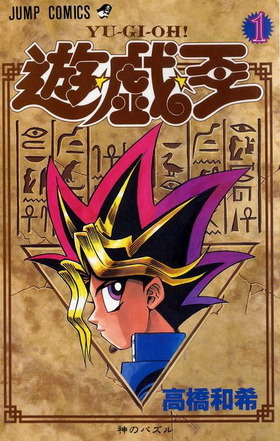
A lot of people prefer the manga. It may even be safe to say that a majority of Yu-Gi-Oh! fans prefer the manga. And I’m sure there are any number of things about the Duel Monsters anime that infuriates them. The animation quality, perhaps. Or the watering down of various plot elements. The sidelining and borderline ruination of Katsuya Jonouchi’s character. All versions of this story have flaws and, for many, I’m sure the anime’s flaws outweigh the manga’s.
That is their prerogative. You will note, I hope, that I leave such fans to their business. My opinion on their preferred canon is not useful to them, so I don’t go out of my way to give it. I would have hoped for the same courtesy in return.
Anon, you were polite in your approach, which is more than I can say for others who’ve confronted me about this topic. With this in mind, I will endeavor to explain why I take issue with the argument you present here, as well as why I don’t like this line of discussion. That may not be what you were looking for in a response, but it’s what I have, and it’s what I will offer.
A note: just because I don’t like the Yu-Gi-Oh! manga doesn’t mean I haven’t read it. I will be using Chapters 1, 9, 10, 24, 25, 27, 39, and 40 to explain my position here. So if anyone reading this hasn’t read the manga, but intends to, keep this in mind before clicking the Keep Reading link. Understand that this is going to be long, it is going to be critical, and I am not open to debate. I have been approached, in my space, and this is going to be my final word on everything I have been avoiding since I started this blog.
If that interests you, then read on. If it doesn’t, then let us part ways here. No harm done. I wish you the best.
Now, then. Let us begin.
The Case Against Inconsistency: Katsuya Jonouchi
Like any story, Yu-Gi-Oh! has various themes that define it. Whether outright stated or just implied throughout, they exist. And one of the things we learn, throughout the story of Yugi, Atem, and their various friends, acquaintances, and antagonists, is this: how people conduct themselves determines their success.
It’s a classic Good VS Evil paradigm, and it’s one that a lot of us are familiar with. How does it play out? Well, in theory, what this should mean is that people who conduct themselves fairly, with honor and integrity, prevail. And people who conduct themselves poorly, with deceit and bitterness, will not. I think that a fair amount of fans of Yu-Gi-Oh! will agree with this idea.
Good people succeed. Bad people fail.
Yu-Gi-Oh! uses its duels like another anime would use a fight scene. When Naruto — or Goku, or Ichigo, or Kenshin, or whichever shonen action hero you fancy — comes up against a new opponent, we expect him to win. Why? Because he’s the hero. He’s the Good Guy™. And that’s how this is supposed to go, right? The hero is supposed to win because if the hero loses, that isn’t fair.
The world isn’t fair, people say. And that’s true. This is why we look to fiction. Or, at least, it’s why I look to fiction. In fiction, the world can be fair. And in a fair world, the good folks win. So that’s what we want to see. We want to see the hero struggle, sure. We want the fight to be hard-won. But we still want it to be won.
In this story’s case, we have Yugi Mutou. He’s our hero. And when we’re introduced to him, we’re given a clear indication of why we’re supposed to root for him.
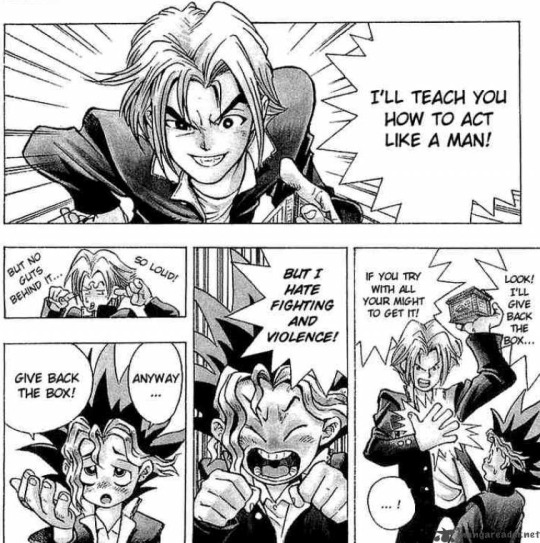
When Our Hero™ is confronted by Katsuya Jonouchi here, right in the first chapter, it’s clear who’s supposed to be sympathetic. Jonouchi is a bully. Taking Yugi’s things away from him and goading him to fight for them. For a story that sets itself up in a high school, this is pretty standard. This is Episode 1 territory. And Yugi, bless him, sets himself up quickly as the good guy. He hates fighting. He hates violence. And those are traits we, as people living in a “proper and civilized” world, should admire.

Hiroto Honda doesn’t come off looking much better. But notice here that, even though Jonouchi and Honda are both antagonizing Yugi, he’s not exactly condemning them. Maybe it’s a defense mechanism. Maybe he’s just scared of getting a rise out of them, because they’re set up as bullies and Yugi is set up as a favored victim. But regardless of why he acts the way he does, I think it’s a pretty safe bet that a lot of people reading this story are going to relate to Yugi, in this moment, before they relate to the other two.
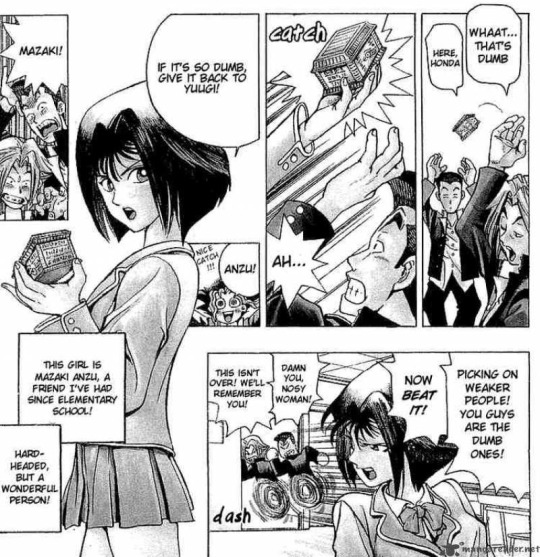
Then, we’re introduced to the second sympathetic character in this opening scene. Anzu Mazaki is quickly established as (1) Yugi’s friend and (2) someone that Jonouchi and Honda are afraid of. This is (tangentially) important to note.
If Yugi has someone willing and ready to protect him, and that someone has the edge over his bullies, then is he honestly afraid of them? Maybe he isn’t. Maybe that’s the point. He doesn’t like dealing with Jonouchi and Honda at this moment, but this presented a question in my head: does he fear them? Are they enemies to him?
Given what happens later on in this chapter, the answer to the former is kind of up in the air, but the answer to the latter is most likely no.
But anyway. A bit later on, we reach the first major point to which I want to draw specific attention. The first major moment that is relevant to why I have take issue with the idea that “Kaiba has literally pushed all his buttons.”

Jonouchi, still angry that things didn’t go his way in the intro scene, has opted to steal a piece of the Millennium Puzzle — which we all know is an immensely important part of this story’s mythology — so that Yugi will never be able to complete it, even if he gets it most of the way there.
The puzzle represents Yugi’s only real goal this early on: he wants friends. He’s heard from his grandfather that the Millennium Puzzle grants wishes, and his wish is for friends. What I mean to point out is that Jonouchi’s behavior here is an immense violation of Yugi’s privacy, and a serious blow against Jonouchi’s integrity. I’ve been robbed before. It’s an absolute travesty, and I have extremely limited sympathy for people who would steal like this. Taking food from a store because you’re starving? I know that’s a classic tactic and maybe it’s a cliché at this point in the game, but still. I’m probably not going to judge anyone for that. Desperate calls and all.
But stealing someone’s most prized possession because you’re sulking? That’s … pretty black-and-white awful in my book.
Some of you might be wondering why I’m going into this much detail about plot elements that occur before Seto even shows up. Others might be wondering how I can say that Jonouchi isn’t worthy of sympathy for what he’s done here, considering what Seto does later on. Well. I’ll get to that.
But for now, consider these points from the remainder of the introduction: Yugi defends Jonouchi and Honda, getting himself beaten up in the process. It’s thus established that these two boys — who are implied to have been bullying Yugi for at least a little while now — are Yugi’s friends. In spite of what we see in the beginning, and in spite of how Jonouchi in particular acts during his introduction, Yugi considers the both of them friends.
The Case Against Inconsistency: Seto Kaiba
Now, then. What about Seto Kaiba, you might be wondering?
When he’s introduced in Chapter 9, there really isn’t much to be said about Seto, other than there’s something off about him. And he really, really wants Sugoroku Mutou’s Blue-Eyes White Dragon.
I want to draw your attention to the first moment when we really sense what’s being set up with Seto’s first chapter.
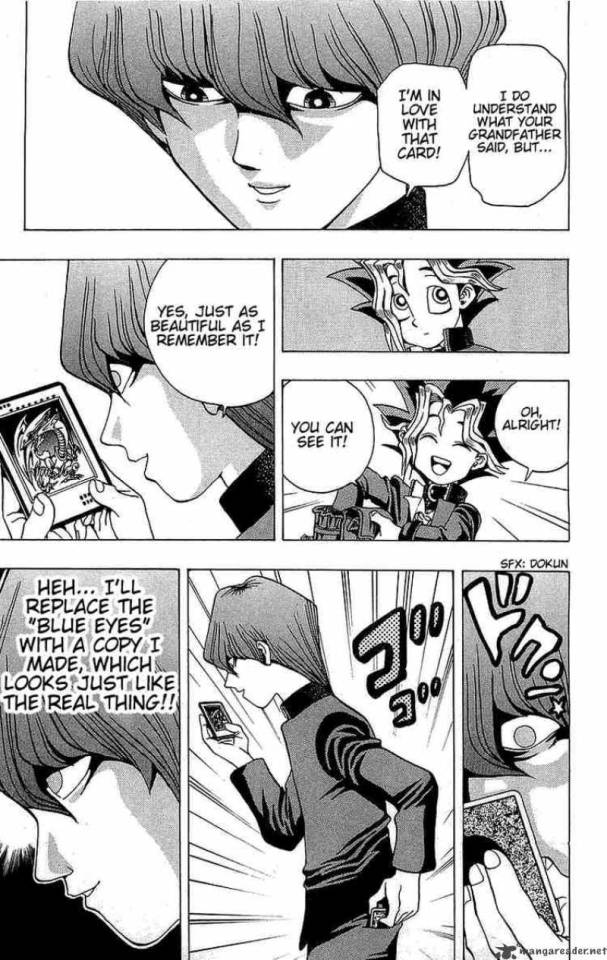
When Seto can’t trade for, or buy, Sugoroku’s card … he decides to steal it. Now. Generally speaking, we would be expected to understand that this is an Objectively Bad Thing™, right? Of course it is. There is no excuse for this kind of behavior. I just covered this.
But recall the specifics: Yugi’s been stolen from before. Does he know that? No. Yugi never figures out that it was Jonouchi who stole that pivotal piece of the Millennium Puzzle. Not directly. But the point I’m making here is: we know it was Jonouchi. We, as the audience, know what happened to the last person who robbed Yugi.
… Absolutely nothing.
This is what I mean when I say that the manga is … weird about enforcing its own rules. Seto Kaiba is set up as a villain for doing the exact same thing Yugi’s own best friend did in the first chapter. Now, let’s look at the other part of Seto’s introductory equation, which occurs when Yugi confronts him about having stolen his grandfather’s prized card.

Seto gets irritated that Yugi won’t let this whole thing go, and clocks him across the face. Now. Seto is not shown in a sympathetic light here. I’m not trying to claim that he is. My point with these scenes — aside from transparency — is simply one of consistency.
Aside from the fact that Seto is rich and Jonouchi is not, there is effectively zero difference between them right now … unless you want to count the chronological order of their respective sins. Jonouchi antagonized Yugi, then stole something important to him. Seto stole something important to Yugi, then antagonized him.
Unless you want to get pedantic, in other words, Katsuya Jonouchi and Seto Kaiba are — textually speaking — the same person. The same obstacle. And given what happened to Jonouchi at the end of his chapter … shouldn’t we expect Seto to get off relatively lightly, too? Isn’t that what we know about Yugi Mutou? That he’s a forgiving soul? That’s what I took from the first chapter.
But what happens?
Well, of course, at this point in the story, we’ve been introduced to The Other Yugi™. Atem, as he will come to be known, the spirit trapped inside the Millennium Puzzle, who comes out and possesses Yugi’s body to extract vengeance — or justice, depending on your point of view — on people who trespass against him. We know very little of what Atem is honestly about during this section, though. We don’t even know his name, or have a nickname for him yet.
What we do know is that Atem plays games to make his points. Games which reflect the nature of the players’ souls. Games which exalt the righteous, and condemn the guilty. So what does this other Yugi do? He challenges good old Kaiba-kun to a game of cards.
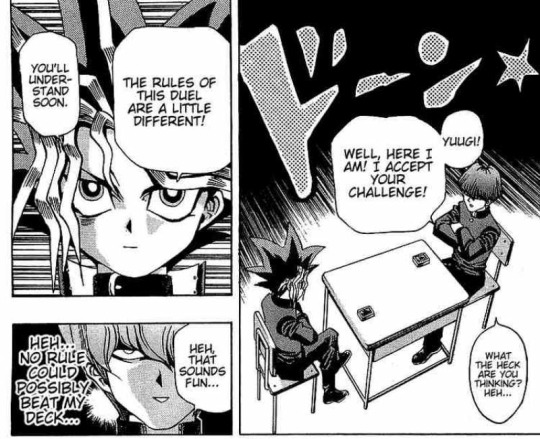
There are a few important points to make about this duel. I’m not going to be giving a play-by-play. Instead, we’ll go over the highlights. First: when Seto realizes that he’s losing the duel, and can’t defeat the spirit, he decides to cheat.
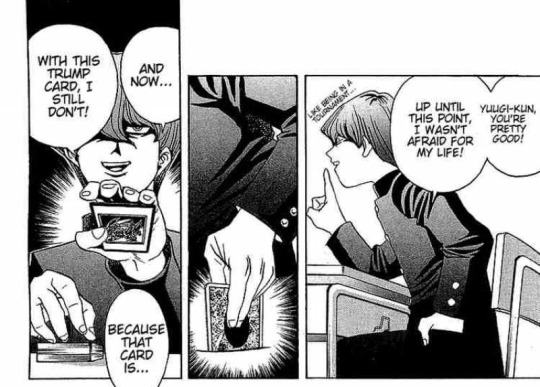
And because this is a Shadow Game, or a Dark Game … a magic game, in other words, Seto is punished. But instead of just disqualifying him and ending the duel, which is what would actually happen if someone cheated like this … it goes on.
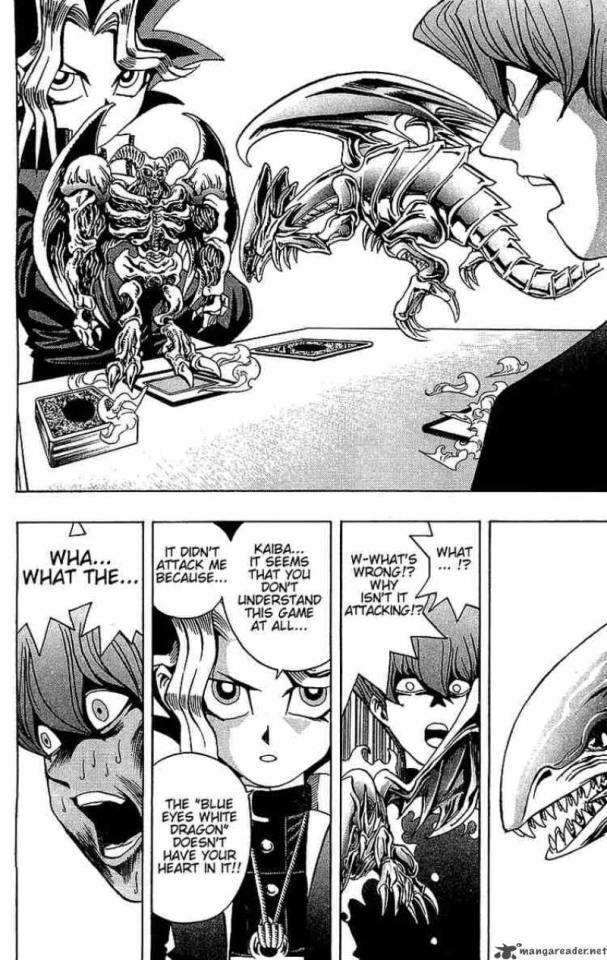
That’s … that is not part of the rules. Nowhere in the initial buildup to this match did Atem specify that Seto’s cards had to have his “heart” in them. And nowhere in the rules of this game does it say that a monster’s attack can be negated by pontificating at it.

Again. This was not established in the beginning of the duel. The rules do not state that a monster that doesn’t belong to the user will be destroyed. Atem did not make this clear when they sat down to play. This is plot armor. Or, rather, a plot weapon. Again, Seto is being punished for cheating. Of course. I cede this point.
But Atem directly benefits from these breaches of the rules. So, by continuing the duel and ultimately winning, he is also cheating. You can’t just decide something like this. Atem did not create this game. He does not have the authority to unilaterally declare how alterations to the rules are decided.
“Well, that guy cheated, so I’m going to cheat, too. And it’s okay when I do it, because he did it first.”
Are we in grade school? That’s the argument being presented, and it doesn’t matter. The duel is canceled and you start over. That is how you handle this. You don’t just arbitrarily alter the rules while the game is ongoing.
But even if you do … you certainly don’t do this when the game is over.
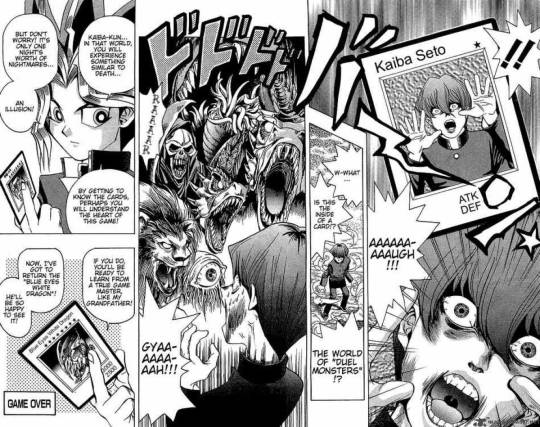
Seto Kaiba is forced, magically, into a literal psychotic break. He is forced through his own death at the hands of the monsters that died throughout the game. Atem claims that Seto shouldn’t worry, because “it’s only one night’s worth of nightmares … an illusion!”
That? Right there? That is horrifying.
Seto cheated at a game of cards. He didn’t commit murder. Is cheating acceptable behavior? No. But the punishment does not fit the crime. Atem condemned a child to his own hallucinatory execution. A child who, you may recall, we later find out grew up in a criminally abusive household, and has just escaped it.
Anon, you acknowledged that Atem is not to be excused, so this next part is not directed at you, but at everyone else who likes to act like Seto Kaiba should be hanged for what he did throughout the manga, but “oh, Atem’s growth is so wonderful and inspiring!”
The above example of other fans’ behavior is facetious and exaggerated and should not be taken seriously. But regardless of how I might view this whole paradigm, it doesn’t change the facts: either they both have crimes to answer for, or they both have redemption arcs worth celebrating.
I do not care what you think about Seto Kaiba. I do not care if you like him. I do not care if you hate him. I do not care if you like or hate Atem. I do not care about Death T. I do not care about how long Atem spent trapped in the Millennium Puzzle. I do not care that Atem sacrificed his life for his country. I do not care that Atem died as a teenager. I do not care how much he eventually grows as a person. I do not care that Seto started this. I do not care that Seto cheated. I do not care that Seto lied. I do not care about any of that.
THIS IS OBJECTIVELY DISGUSTING.
Don’t tell me why you think Seto deserved it. Don’t excuse this. Don’t ignore this. Don’t you dare come into my space and tell me this is irrelevant. I will never let this slide. Seto Kaiba is a child, and he just got what little emotional equilibrium he had, after having survived Gozaburo Kaiba, shattered because he cheated at a game of cards.
Recall, if you please, my previous point.
Katsuya Jonouchi stole from Yugi Mutou, and antagonized him.
Seto Kaiba stole from Yugi Mutou, and antagonized him.
One got a best friend out of it.
One got tortured.
That is not acceptable, and it is not justice.
The Case Against Inconsistency: Mokuba Kaiba
Are we done? No. No, we are not.
There are fewer points to make in this section, so it will be shorter, but there are still important notes to take into account before we move on to the main event.
I always say: you don’t get one Kaiba without the other.
In Chapter 24, we’re introduced to Seto’s little brother.

Baaaan.

Mokuba is portrayed, initially, just as unsympathetically as Seto is. Like his brother, this kid presents a threat. A pretty substantial one, if those weapons are real. And given the early manga’s penchant for wanton violence, they probably are. For a story about children’s games, there’s a lot of … not-so-child-friendly elements to the opening chapters.
Naturally, given that this is a series about games, there have to be stakes. And Mokuba is very quick to establish what those stakes are.
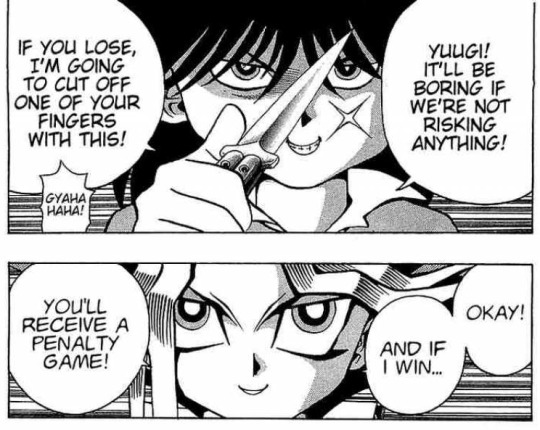
And Atem is equally quick to accept them. Now, look. Obviously brandishing CEWs, assault weapons, and butterfly knives at people are entirely unacceptable actions to take, but these aren’t even teenagers we’re dealing with. Atem is a bit too gleeful for my tastes here, considering he just promised to torture a 10-year-old boy.
These are grade-schoolers.
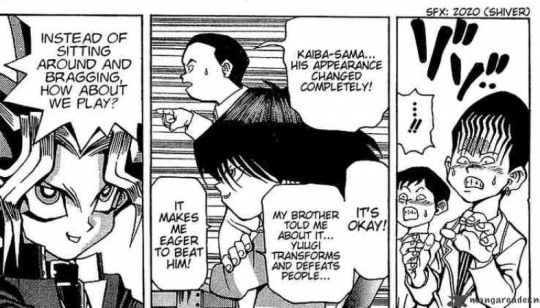
Grade-schoolers who, aside from Mokuba, are obviously unnerved (and possibly frightened) by the spirit of the Puzzle. Now, I’m not saying it would have been smart on Yugi’s part to deny these kids whatever they wanted. But this is why you have a cursed pendant with a ghost inside it to help you out.
But, perhaps it isn’t fair to say that Yugi’s new vengeful friend should have worked harder to dissolve the situation. Maybe that’s not the right argument to make. After all, Mokuba started it. And who knows what he might do if he’s denied?!
Well. Considering what happens when Atem wins this game … I don’t think he really avoided any potential consequences by going along with what his attackers wanted.

See, you say that, Atem, but I don’t believe you when you say that Mokuba isn’t your enemy. You’ve treated him the same way as you have every other enemy you’ve come across in this story. The only net positive we can say here is that Mokuba doesn’t die.
Now. What’s my point with bringing this one up? Well, one, I don’t think the 10-year-old kid should have been forced into a confined space. What if he’s claustrophobic? What if his father used to lock him in his bedroom? What if, what if, what if. Atem doesn’t know anything about this boy except that he’s lashing out on his brother’s behalf.
And two: when you play with fire …
Obscenely rich, angry, chronically abused fire …
You get this.
The Case Against Inconsistency: Mind Crush
When the chapter that opens up the oh-so-infamous Death T starts, we get treated to two bits of information that are … extremely important to all of this. We are first reminded of what Atem forced Seto through, at the end of their first duel.

And then we are shown that Atem was wrong about his own consequences. He said, and I quote:
“It’s only one night’s worth of nightmares.”
Remember that? And yet, we see that Seto has had that nightmare at least twice. Time is nebulous in the manga, so it’s difficult to figure out how often he’s had this nightmare, but that isn’t important. He’s had it multiple times.
This is a problem, because our hero said it would happen once.
But it didn’t happen once.
Why is this such a big deal to me? Because when your hero’s entire problem with an antagonist is how dishonest he is, you cannot afford to be dishonest yourself. But here, Atem is shown to have been either ignorant of his own abilities, which is reckless, or outright lying.
Which is hypocritical.
My point is not that Seto Kaiba is blameless. It is not that I want people to stop paying attention to his faults. My point in all of this is that Death T — to which Anon is referring — did not happen in a vacuum, and Atem was partially responsible for it. Death T was not constructed to beat Yugi Mutou in a game. It was, and is, not a sign of Seto’s unhealthy obsession with victory.
Death T was a direct result of two things: Gozaburo Kaiba, and the “Experience of Death” penalty game.

Seto says nothing about losing. He says nothing about being beaten. His whole motive for Death T is to stop “that nightmare.” What does this mean? That if he had not had that nightmare, he would not have that motive. Would he have done something else? Maybe. Probably, even. But we’re not talking about possibilities. We’re talking about what happened.
And what happened is: Seto cheated at a game, was punished by a hallucination, had nightmares about that hallucination, and figured out a plan to stop them. Would Death T have worked? No. Is it acceptable behavior? No. Am I saying Seto Kaiba should be absolved for what he put the main cast through? No.
I am saying that it wasn’t just Seto Kaiba who was responsible for this.
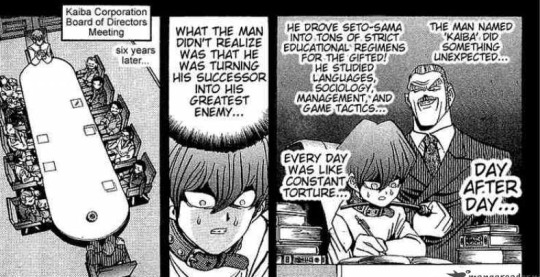
There was also Gozaburo Kaiba, who tortured his adopted son to mold him into the heir that he wanted.
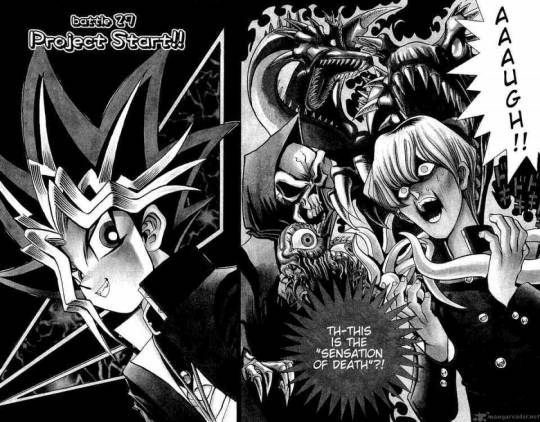
And Atem, who tortured his classmate to mold him into the opponent that he wanted.
You aren’t going to find many people willing to give Gozaburo Kaiba the benefit of the doubt. He’s pegged pretty constantly for the villain he is. Seto is also held accountable for the horrible things that he did. Death T was, and is, an atrocity. But Atem’s hands are not clean. He directly antagonized an unstable teenager with PTSD, one with the resources, the conviction, and the warped sense of right and wrong (courtesy of his aforementioned abusive father) to push right back.
Was it right? No. Was it fair? No. Was it acceptable? No.
So why talk about it?
Because when you say things like “Kaiba has literally pushed all his buttons,” you absolve Atem of what he did.
Atem tortured, and killed, several people in the name of justice.
The Kaibas were just the first of his victims to fight back.
Seto Kaiba pushed Atem too far? Fine.
Atem pushed him too far, too.
And only one of them ever gets taken to task for it.
If it makes me the Devil’s Advocate to focus on that, and harp on it, and get angry about it … so be it. I’m used to being the voice of dissent. And just so you all understand: I don’t like the way Seto is portrayed in the manga. I hate it. I hate him. That’s why I don’t deal with him. That’s why the anime is my focus. That’s why I don’t talk about the manga. I don’t like Seto, I don’t like Atem, I don’t like Honda, I don’t like Otogi, I don’t like Pegasus, I don’t like the Ishtars.
I don’t … like … the manga.
But, that being said.
No matter what he did.
No matter how far he went.
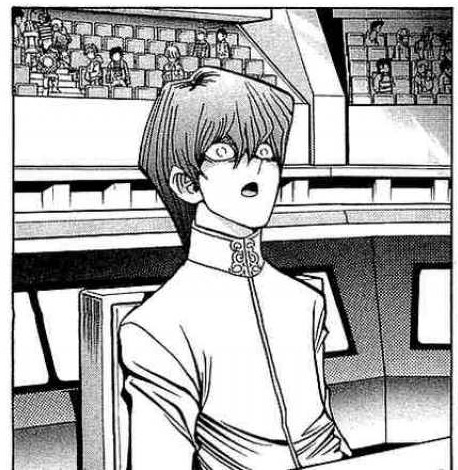
This is not heroic.
This is not worth celebrating.
This is not my Yu-Gi-Oh!
And I’m done talking about it.
#i'm not tagging this the way i usually do#i'm serious when i say i'm not open to debate#so i'm not tagging it with any series or character tags#there is only one relevant tag here#i stand with the dragon king
63 notes
·
View notes